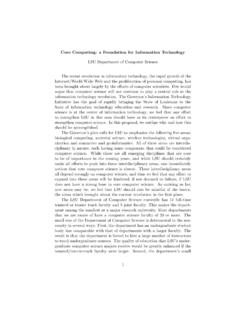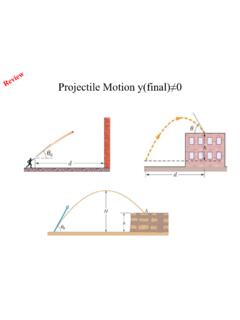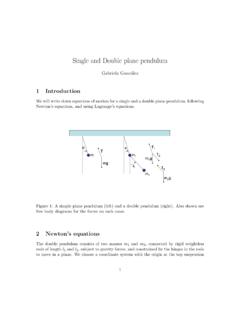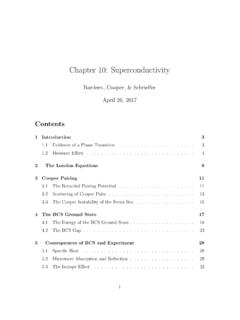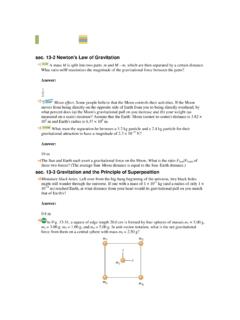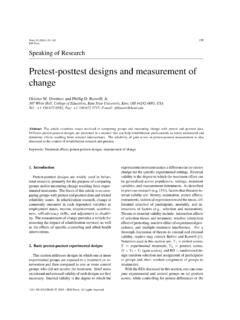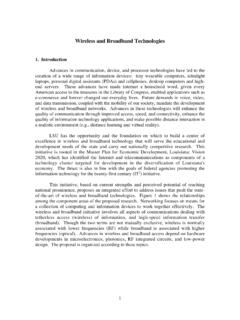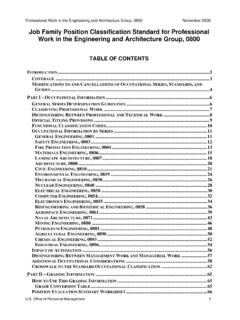Transcription of PHYS 7221 - The Three-Body Problem
1 PHYS 7221 - The Three-Body Problem Special Lecture: Wednesday October 11, 2006, Juhan Frank, LSU. 1 The Three-Body Problem in Astronomy The classical Newtonian Three-Body gravitational Problem occurs in Nature exclusively in an as- tronomical context and was the subject of many investigations by the best minds of the 18th and 19th centuries. Interest in this Problem has undergone a revival in recent decades when it was real- ized that the evolution and ultimate fate of star clusters and the nuclei of active galaxies depends crucially on the interactions between stellar and black hole binaries and single stars. The general Three-Body Problem remains unsolved today but important advances and insights have been enabled by the advent of modern computational hardware and methods. The long-term stability of the orbits of the Earth and the Moon was one of the early concerns when the age of the Earth was not well-known.
2 Newton solved the two-body Problem for the orbit of the Moon around the Earth and considered the effects of the Sun on this motion. This is perhaps the earliest appearance of the Three-Body Problem . The first and simplest periodic exact solution to the Three-Body Problem is the motion on collinear ellipses found by Euler (1767). Also Euler (1772) studied the motion of the Moon assuming that the Earth and the Sun orbited each other on circular orbits and that the Moon was massless. This approach is now known as the restricted Three-Body Problem . At about the same time Lagrange (1772) discovered the equilateral triangle solution described in Goldstein (2002) and Hestenes (1999). The collinear and equilateral triangle solutions are the only explicit solutions known for arbitrary masses and a handful of solutions for special cases are also known (Montgomery 2001).
3 The basis for the modern theory of the restricted Three-Body Problem was developed by Jacobi (1836), Delaunay (1860), and Hill (1878). The classical period ends with the powerful methods of surfaces of section, phase space and deterministic chaos developed by Poincare who was awarded in 1889 the prize established by Sweden's King Oscar II for the first person to solve the n-body Problem . Although, strictly speaking, Poincare did not solve the general 3-body Problem , let alone the n-body Problem , his insights influenced much of the work that followed. I will review some of the known exact solutions valid for special cases, sketch out a few aspects of the restricted Three-Body Problem and conclude by discussing some numerical results and astrophysical applications. 2 The General Three-Body Problem Just as in the two-body Problem it is most convenient to work in the center-of-mass (CM) system with xi denoting the position of mass mi.
4 The Newtonian equations of motion in this system are of the form xi xj xi xk x i = Gmj Gmk (1). |xi xj |3 |xi xk |3. where i, j, k stand for 1, 2, 3 and the two ordered permutations of these indexes. These three second- order vector differential equations are equivalent to 18 first order scalar differential equations. The CM condition and its first derivative i=3. X. mi xi = 0 (2). i=1. 1. i=3. X. mi x i = 0 (3). i=1. are 6 constraints that reduce the order of the system to 12. In the absence of external forces and torques, the energy and angular momentum are conserved quantities or integrals of the motion. These further reduce the order of the system to 12 4 = 8. As in the two-body Problem , one could eliminate the time and reduce the order by one, and using an analog procedure to fixing the line of nodes, reduce it again to 6. Even if the motion was restricted to a plane fixed in space, the order is reduced to 4 which is still unsolvable in general.
5 Figure 1: Position vectors in the CM system and relative position vectors for the Three-Body Problem (Hestenes 1987). In 1973 Broucke & Lass realized that the equations of motion could be written in a more symmetrical form by using the relative position vectors si = xj xk , labeled in such a way that the si is the side opposite to the vertex of the triangle containing the mass mi (see Fig. 1) and that s1 + s2 + s3 = 0. (4). In terms of these relative position vectors, the equations of motion (1) adopt the symmetrical form si s i = GM + mi G, (5). s3i where M = m1 + m2 + m3 is the total mass and the vector G is given by i=3. X si G= (6). s3. i=1 i Note that the first term on the of (5) is identical to what one gets in the standard treatment of the two-body Kepler Problem , which admits conic sections as orbital solutions. It is the second term that is responsible for the difficulty in this Problem since it couples the equations for the si.
6 3 Euler's Solution If all particles are collinear, all the vectors si , xi and G are proportional to one another. Without loss of generality let's suppose that m2 lies in between the other two masses. Then s3 points from 2. m1 to m2 , s1 points in the same direction and sense as s3 from m2 to m3 , and s2 points back from m3 to m1 . Therefore, we can write s1 = s3 , s2 = (1 + )s3 , (7). where is a positive scalar. Expressing everything in the equations of motion in terms of s3 and lambda, one obtains after some algebra (see Hestenes 1987 for details) a fifth degree polynomial in . with one single positive real root which is a function of the three masses; and, s3 obeys a two-body equation of the form m2 + m3 (1 + ) 2 GM s3. s 3 = . (8). m2 + m3 (1 + ) s33. Thus the particles move along confocal ellipses of the same eccentricity ( similar ellipses) and the same orbital period around the common center of mass, always lined up and separated by distances obeying eq.
7 (7). This describes one family of solutions. The other two families can be found by putting one of the other particles in the middle. On a sober note, these collinear solutions are not realized in nature because they are unstable to small perturbations. Figure 2: Euler's collinear solution for masses in the ratio m1 : m2 : m3 = 1 : 2 : 3 (Hestenes 1987). 4 Lagrange's Solution This case is realized when G = 0 and the equations for the si decouple. The three decoupled equations have the two-body form whose solutions are ellipses for bound cases. The condition for G = 0 is that s1 = s2 = s3 , in other words the particles sit at the vertexes of an equilateral triangle at all times, even as this triangle changes size and rotates (see Fig. 3). Each particle follows an ellipse of the same eccentricity but oriented at different angles, with the common center of mass at the focal point of all three orbits.
8 The motion is periodic with the same period for all three particles. The Lagrange solution is stable only if one of the three masses is much greater than the other two. Montgomery (2001) describes several other solutions that exist when all the particles have the same mass, a figure-eight solution for 3 particles, which is stable, and even more complicated solutions with up to eleven (!) particles. Although these exact solutions are fun, they are of very little practical importance since they require very special initial conditions to be realized. 5 The Pythagorean Problem Burrau (1913) considered a well defined but arbitrarily selected initial configuration of three bodies of masses 3, 4 and 5 placed at the corners of a Pythagorean triangle facing sides of length proportional 3. Figure 3: Lagrange's equilateral triangle solution for masses in the ratio m1 : m2 : m3 = 1 : 2 : 3.
9 (Hestenes 1987). to each mass. The initial configuration is shown on Fig. 4. The masses are at rest initially and begin to move due their mutual attraction. After a very complex interaction, the two heavier masses bind in a stable binary while the light object escapes, and all particles recede without limit from the common center of mass. Fig. 5 shows the time-development of the orbital paths of the three P1 (1, 3). m1 = 3. P2 ( 2, 1) P3 (1, 1). m2 = 4 m3 = 5. Figure 4: Initial configuration for Burrau's pythagorean Problem shown in the CM reference frame. The masses are in the ratios m1 : m2 : m3 = 3 : 4 : 5 and are released from rest (Valtonen &. Karttunen 2006). particles. This behavior turns out to be quite common when three particles of roughly comparable masses are allowed to interact gravitationally with randomly selected initial conditions. Modern computer experiments have explored the outcomes of hundreds of thousands of initial configurations and have allowed the development of a statistical understanding of the interactions between three particles, of a binary with a third object and of binaries with binaries.
10 6 The Restricted Three-Body Problem : Roche's Potential We illustrate the standard techniques involved in the restricted Three-Body Problem by considering the motion of gas, or alternatively non-interacting particles, in and around an interacting binary with a circular orbit (adapted from Frank, King & Raine 2002). Non-interacting particles feel the 4. 6 6. 4 4. 2 2. 0 0. -2 -2. -4 -4. -6 -6. -6 -4 -2 0 2 4 6 -6 -4 -2 0 2 4 6. t = 40 t = 60. 6 6. 4 4. 2 2. 0 0. -2 -2. -4 -4. -6 -6. -6 -4 -2 0 2 4 6 -6 -4 -2 0 2 4 6. t = 20 t = 70. 6 6. 4 4. 2 2. 0 0. -2 -2. -4 -4. -6 -6. -6 -4 -2 0 2 4 6 -6 -4 -2 0 2 4 6. t = 10 t = 80. Figure 5: Trajectories for Burrau's pythagorean Problem shown in the CM reference frame. The last two panels are identical since both the binary and the light particle have left the frame (Valtonen & Karttunen 2006). external gravity of the stars but do not interact with each other.

